We might well wind up the era of Napoleon with this incident from a battle not as widely celebrated as many, but which must yet ever interest artillerymen on account of the part played in it by their arm, but ere we close this portion of our subject, it may be right to notice the effect which was produced at Waterloo by the 76-gun great battery, which prepared the attack of D'Erlon in the centre.
All accounts of the battle have borne eloquent testimony to the effect of these guns, and the performance deserves mention, for it was not due to lack of artillery that the French were repulsed. Great as their effort, however, they failed to exert a decisive effect as the immediate attack failed.
Artillery is expensive to train and equip, and vulnerable in mobility. Just as the great British leader was obliged to conserve his cavalry, so it was with artillery, in which he was weak, and which he felt he could not risk.
Just for the same reasons that the pursuit was never vigorously pressed by Wellington, it was that his guns were not handled in the bold and independent manner which, if it endangers their safety, at least assures that of the other arms, and most often leads to decisive success. A military despot with the whole resources of the State at his back may hazard strokes which a General whose minutest action may be criticised and pulled to pieces by an assembly of civilians confident and inexperienced dare not incur.
One feat of the Peninsula days is, however, widely celebrated, that, namely, which Norman Ramsey's troop perform at Fuentes d'Onore , and this seems out of place in this discussion. "L'artillerie n'a qu' une tactique - le feu." [1] What lies outside the sphere of fire may fascinate us with magnificence, but it is not war. A splendid piece of daring is missing from this record, although it be justly dear to the regiment and deserves to be cherished as an instance of what a quick eye and instant decision may accomplish. [2]
Small isolated cases, too, where a few guns or even a
single battery have been equal to some difficult occasion, or
have attracted notice by their soldierlike conduct, have also
been left out of an account which does not pretend to be
exhaustive, and which aspires to cover an immense period of
time. It may be mentioned, however, that when Fakenham's
division at Salamanca, fell on Thomiere's flank and struck the
decisive blow of the day, the fire of the 12 guns which
accompanied it was most effective, and went far to bring
about the destruction of the French. Admirably
placed in a commanding position on the flank of the enemy's
column, they suddenly took their enemy in his weakest
point, just as Blucher's guns at Bautzen surprised Ney, and
assisted materially in driving home a success which
developed into a brilliant victory.
Shortly after this battle, during the cavalry action at
Ribera, on the 24th July, 1812, when General Long's force
defeated the French under General Lallemand, "D" Troop,
R.H.A., so highly distinguished itself that during a
subsequent truce the French leader took the opportunity to
send the following message to Captain Whinyates [3] :
To be mentioned in your foe's dispatches is perhaps
a higher tribute than to find a place in those of your own
side, and the performance must have been brilliant which
called forth so chivalrous a message.
In Colonel Whinyates' history [4] of "C" Battery, R.H.A.,
from which the foregoing incident has been taken, an
example of effective action on the part of a small number of
guns is also to be found which deserves again to be recalled
to memory.
At the battle of Albuera, 16th May, 1811, the
'most sanguinary and awful combat that has been fought
in the Peninsula,' "D" Troop [5] which consisted of only
four guns, was in the very thick of the melee, and though the
guns were repeatedly charged or ridden through by the
French cavalry, their attack was checked at a most critical
part of the battle by the effective fire which they brought to
bear.
Marshal Beresford, in his dispatch, says
It is thus that Brigadier-General R. B. Long, [6] in a letter dated the 26th
June, 1811, from the bivouac near Vicente, speaks of the
services of this troop, D.
Nor can we leave unnoticed the part played by the
artillery at Vittoria, the only triumph of the arm during the
war, and the battle most decisive in its results of any which
our army gained in Spain even if no deeds that fascinate the
imagination, such as the giant blows of Senarmont or
Lauriston, can be recorded from that fight.
It has been whispered that the Duke of Wellington
did not understand artillery tactics thoroughly, and failed
somewhat to appreciate how the arm might best be turned to
account. It is at any rate certain that we do not find guns
employed in masses during the Peninsular campaigns except
at this battle - a fact, however, which we are rather inclined to
attribute to the causes which we have already mentioned
than to any tactical prejudices of the Duke's. It is, however,
an odd coincidence that in the battle where our batteries
most distinguished themselves, and where their effect was
due to the manner in which they were employed in masses,
their concentration was due rather to good fortune than
good guidance on his part, just as had been the case with
Daun at Torgau.
.Without attempting a full account of this great
battle, or of the events which led up to it, we may tell how
the French, under Joseph Buonaparte, retreating from
Burgos before Wellington, found themselves on the 21st
June, 1813, in the low lying ground which forms a basin
in front of Vittoria, with immmense convoys of baggage and
spoil on a single road, was menaced by Graham.
Wellington determined to assault the enemy in three
different attacks. Graham was to attack the right with 20,000
men and 18 guns to cross the Zadora at Gamera Mayor and
Ariga and cut the line of retreat.
Hill, with 20,000 men, was to cross the river at Puebla
and threaten the enemy left, and Wellington himself with
30,000 men and the great mass of guns, was to attack the
centre by the bridges of Mendoza Tres Fuentes, Villodas,
and Nanclares.
At 1 o'clock Hill had gained the village of Subijana in front
of the enemy's left, and the smoke of Graham's guns seen up the valley of the river
showed that he too had launched his men to the attack. The
allied centre attack had reached the various bridges it was to
cross by, and was engaged with the enemy in desultory
combats, waiting till the moment for a decisive advance was ripe.
The King, anxious for the safety of his line of retreat,
now commenced to move his reserve to the rear, and was
contemplating a general withdrawal when the 3rd and 7th
Divisions of the Allied force made a rush on the bridge at
Mendoza and crossed the river, while the light division
moved from to Tres Fuentes, and crossing there took the
advanced French post in rear, and the French were forced to
take up a position on the heights before Arinez. The 4th
Division under General Cole, also advanced from the bridge
at Nanclares, joined in the attack of the left wing, and the
heavy cavalry, also passing the river, filled the interval
between Cole and Hill.
When the French were thus caught in the midst of
their dispositions for retreat, they threw out a great battery
of 50 guns which, supported by crowds of skirmishers, gave
breathing time to their hard pressed comrades by the
effective and active fire which they kept up on the
advancing enemy. Then the first great artillery duel of this
battle, rich in artillery achievements, commenced, for
Wellington called to his assistance several brigades of
British guns, and the front of both armies was soon
shrouded in the dense smoke of the contending artilleries.
During this contest the French gradually drew off their
troops to a second position in front of Gomecha, where they
had posted their reserve, but their rear-guard still clung to
the village of Arinez, and held back the rising tide of the
Allied onset.
But Picton's and Kempt's brigades after severe
fighting succeeded in carrying the village, and the 7th
Division on their left, and the 4th on their right were soon
also triumphantly forcing their way onward.
Thus it was that the French troops at Subijana found
their position turned, and being hard pressed, both in their
front and on their left, they fell back in a, disordered mass
and tried to gain the great line of retreat to Vittoria. Soon they
dissolved into a more or less confused multitude, and but for
the broken nature of the ground would have been totally
disorganised and destroyed.
As it was, many cannon were taken, as the English
followed them in a running fight, nor was any effective stand
made until they gained the last defensible height about a mile
in front of Vittoria. There they turned and faced their foes, for
chaos reigned behind them, between them and the city, and
the plain was blocked with a confused collection of carriages
and animals, noncombatants, women and children, all
huddled together in panic stricken helplessness. As Napier
says: "It was the wreck of a nation."
With desperate energy the French gunners laboured
to delay the ruin they could no longer avert, and 80 guns
massed together again opened a terrible cannonade, while
the remains of their armies formed up between the villages of
Ali and Armentia and made a most determined resistance.
Now it was that another famous artillery duel took
place, and that our guns, handled with an unusual boldness,
and in a manner calculated to develop their effect to the
fullest extent, did such excellent service. The great mass of
French guns brought our advance for a time to a stand-still,
and they had begun to disengage their infantry in
succession from the right, when the 4th Division carried the
hill on their left and immediately all the heights were
abandoned.
Seeing the great road blocked, the French
endeavoured to gain another line of retreat, and moved so as
to leave Vittoria on their left. The new road, however, led
through a marsh, and was soon as impassable from the press
of fugitives and vehicles upon it as had been the other. Thus
everywhere there was confusion, and no outlet for escape.
The rout was in fact complete, guns, ammunition and stores
were abandoned, and trophies innumerable fell into the
victors hands.
While Wellington was thus winning his battle, a
detachment of Graham's column had gained the royal road at
Durana and had denied it to the French. The part of his force,
however, which endeavoured to cross the Zadora at Gamara Mayor was held in check, and at the bridge of Ariaga, which
Graham himself had attacked, the French were also able to
keep their foes stationary. But when Wellington's advance
reached Vittoria, Reille, who commanded French forces on
the right, saw his rear threatened by British cavalry, who
penetrated Vittoria and emerged between that town and the
river. The Allies were in fact soon coming down on him from
Durana, Ariaga, and Vittoria, and but for the resolve he had
formed at Betonio, and which covered his retreat, his
situation was desperate. As it was, he was able to gain
Metauco on the general line of retreat in some order, although
he could not extricate himself without the most determined
efforts on the part of those he led. Thus ended the battle, but
not the efforts of the English artillery, for during the pursuit,
they were at hand whenever required, and in the hands of Sir
Alexander (then Col.) Dickson, gained high praise from the
Duke of Wellington. In his despatches he wrote of it,
"The army is particularly indebted to that corps."
The number of guns captured from the French
amounted to 131 besides 415 caissons, 14,249 rounds of
ammunition, 40,668 lbs. of gunpowder, and 1,973,400 musket
cartridges, besides an immense quantity of treasure and
other spoils. For the services of the artillery on this occasion
a special boon was granted to the senior officers engaged
which was to commemorate, in the words of Lord Mulgrave,
the Master-General of the Ordnance, to Colonel Dickson
[8] ,
He goes on to say
These very exceptional rewards, highly complimentary as they were to the Royal Artillery, having been decided on without reference to the Duke of Wellington, proved anything but the boon intended, and to them and the circumstances under which they were granted is to be attributed the prejudice which must have biased the Duke's mind when he wrote in terms of most unmerited disparagement of the behaviour of the artillery at Waterloo.
Until his letter appeared to light in 1872, there appeared to be a concensus of opinion as to the gallantry displayed by our troops and batteries in the most decisive battle they had ever taken part in.
To those anxious to master all the details of the controversy set on foot by the letter referred to, the pages [9] of the "History of the
Regiment" are open, and eloquent testimony is brought forward in them to vindicate its reputation. Here it can only be added that artillery cannot advance to reap the harvest of
its performances as do the other arms, and can bear back no trophies to keep green the memory of their deeds.
Mercer's battery at Waterloo. By J. Girbal from L'Epopee Napolionenne.
And further, it may be justly claimed that the great cavalry charges on our line at Waterloo were chiefly defeated by the fire of our guns served up to the very last moment with splendid courage by our gunners, and with most destructive results. Mercer's journal has made us all familiar with the story, and the pile of dead he tells us was so high in front of where his troop stood that it was noticeable from the French position on the opposite slope.
Major Rudyard, [10] writing to the historian of the campaign of his experiences, says of the doings of his battery Sir Augustus Frazer says-
The victory at Waterloo was due to the harmonious co-operation of all three arms striving loyally for the same object and controlled by a master hand in tactics in united and reciprocating efforts. It would be invidious and ungracious to endeavour nicely to gauge the exact proportion of their individual shares in a result due so greatly to the courage and self- sacrifice displayed by all alike. Nevertheless, in cases where an arm, owing to the absence of
any tangible trophies, has had its performances called in question by our leader, and has in consequence perhaps hitherto received less than its fair share in the credit of the day, it
may justly assert the value of co-operation which, if it accomplished nothing exceptionally brilliant, was none the less real and effectual. While men died, or retreated to securer positions, the guns remained in position, and, temporarily overwhelmed, were ever found as the fight rolled back uninjured where they had been left. The arm least affected by losses was always ready to do its work as soon as the retreating wave allowed it to be again manned, and
the iron front of the guns ever remained, no matter how much thinner the line grew on either side, while the redoubled exertions of their diminishing detachments kept them still supplied with an unslackening fire. It is scarcely possible to exaggerate the encouragement that must thus have been afforded, but who may accurately measure it, or define its value in a narrow paragraph?
Note:
The two following extracts highlight the high reputation
of the quality of the British artillery at the close of the Napoleonic era:
In the 'Memoires du Marechal Marmont, Duc de Raguse', Tome 7, page 116 is to be found the following passage:
Mercer also says:
"It seems that we (ie the Horse Artillery) have been
the rara avis of the day ever since our review. The rapidity of
our movements, close wheeling, perfection of our equipment,
etc., etc., excited universal astonishment and admiration. The
consequence of this was an application to the Duke for a
closer inspection, which he most magnanimously granted,
and ordered Ross's Troop out for that purpose. They
paraded in the fields near Clichy. The reviewers were, I
understand, Marechaux de France, but there was also a great
concourse of officers of all nations.
After the manoeuvres the Troop was dismounted, and
a most deliberate inspection of ammunition, and even of men's
kits, appointments, shoeing, construction of carriages, etc.,
took place. I believe they were equally astonished and pleased
with what they saw, and, as there were several among them
taking notes, I have no doubt that we shall soon see
improvements introduced into the 'Continental Artillery." (Mercer's Memoir, Vol II, pages 194, 195). [1] de Heusch
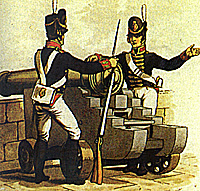 Royal Artillery Gunners 1815
Royal Artillery Gunners 1815
"Tell that brave man that if it had not been
for him I should have beaten your cavalry, but that, meeting
me in every movement with his fire, he never would allow
me to form for attack. Say that I shall mention his name in
my orders as having been the cause of our defeat, and not
your cavalry. Be sure to tell him this. Promise to give him
my message."
"The four guns of the Horse Artillery,
commanded by Captain Lefebure" (with whom also
was Captain Whinyates) "did great execution on the
enemy's cavalry."
"The dispersion of our cavalry scarcely left us
400 or 500 British at any point, and these, with two
regiments of Spaniards, were all we had to offer by way of
resistance to their numerous and overwhelming columns.
The ground, however, favoured us, and the Horse Artillery
did its duty with brilliant effect. The enemy lost a great
number of men, and from 400 to 500 horses, by the
operation of this arm alone!"
"The nature of the country [7] and want of
roads, was the means of throwing a large proportion of our
artillery together, away from their divisions, which I availed
myself of, and by employing them in masses it had a famous
effect. This was adjoining the great road to Vittoria; and the
French brought all the artillery they could to oppose our
advance, so that the cannonade on one spot was very
vigorous. In none of our Peninsular battles have we ever
brought so much cannon into play; and it was so well
directed that the French were generally obliged to retire ere
the infantry could get at them. There were few or no,
instances of the bayonet being used during the
day. "
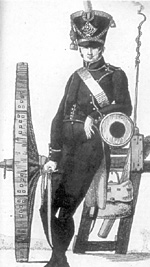 Gunner, foot artillery, 1808 - 1812
Gunner, foot artillery, 1808 - 1812
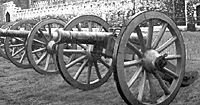 French cannon captured at Waterloo.
French cannon captured at Waterloo.
"The very striking and unexampled
circumstance of the whole of the British artillery having
been brought into action, and the whole of the enemy's
artillery having been captured."
"His Royal Highness has been graciously pleased - in consideration of
the peculiar circumstance above stated -- to mark his Royal
Highness's approbation of the particular and successful
activity of the corps of Royal Artillery under your
orders, by granting severally to the officers entrusted with the
command of divisions or brigades an allowance for good
service in the folowing proportions: to the officers
commanding divisions, each 10s. per diem; to the officers
commanding brigades, each 5s. per diem; and to yourself a
similar allowance for good service of 20s. per diem."
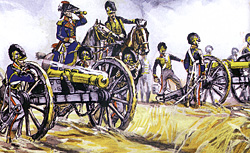 It is our proud boast that at Waterloo, as in all our glorious battles at
the commencement of the century, which were mainly fought against superior odds, our guns formed the rallying points to or lines, lent the steady support to the infantry which they
most needed, and rendered possible the ultimate advance, in the glory of which they could not participate, but of which they justly may demand a share.
It is our proud boast that at Waterloo, as in all our glorious battles at
the commencement of the century, which were mainly fought against superior odds, our guns formed the rallying points to or lines, lent the steady support to the infantry which they
most needed, and rendered possible the ultimate advance, in the glory of which they could not participate, but of which they justly may demand a share.
 Front: British brass 6-pounder Horse Artillery piece
Front: British brass 6-pounder Horse Artillery piece
Back: British brass 9-pounder, the British armies standard gun in 1815 © David Chandler
"When advancing on our fire I have seen four or five men and horses piled upon each other like cards, the men not having even been displaced from the saddle, the effect of canister."
"The earlier hours of the battle were chiefly affairs of artillery but, kept down by the admirable and steadily continued fire of our guns, the enemy's infantry could not come on en masse, and his cavalry, though bold, impetuous, and daring; was forced to try the flanks rather
than the front of our position. The steadiness of our infantry too, became confirmed by the comparative repose afforded by our fire."
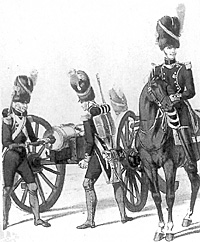 Foot Artillery of the Imperial Guard 1810 - 1815 Artist: Marbot
Foot Artillery of the Imperial Guard 1810 - 1815 Artist: Marbot
"Before leaving Ghent in 1815, previous to Waterloo, I wished to see a company of English Horse Artillery which was there. The English material is so different from what we used
formerly that the comparison was curious. I therefore examined it in detail, and I admired the simplicity of the construction, since adopted in France."
"Being on the subject of reviews, I may as well note here one that took place yesterday, which I have just heard of but did not see."
Footnotes
[2] It is to be noted, however, that it is
extremely doubtful whether the feat of Norman Ramsay was on as large a scale as is
usually supposed, and that it is not by any means certain that more than a portion
of a troop took part in it.
[3] Afterwards Sir EC Whinyates,
Commandant of Woolich Garrison.
[4] See "From Corunna to Sevastopol"
The History of 'C' Battery 'A'
Brigade. By Colonel FA Whinyates, formerly Commanding the Battery.
[5] 'D' Troop had only four guns at
Albuera, the other two being still dismounted at Lisbon. It may be as well to remind
our readers also that this troop, which was reduced in 1816, is in no way connected
with the battery which at present bears the same letter.
[6] Commanding the brigade of cavalry to
which 'C' Troop was attached.
[7] See a letter from Colonel Dickson
quoted in Duncan's "History of the Royal Artillery, Vol II
[8] See
Duncan's "History of the Royal Artillery".
[9] Appendix to Duncan's
"History of the Royal Artillery.
[10]
Siborne's "Waterloo Letters", No 99.
Back to Table of Contents -- Age of Napoleon #31
Back to Age of Napoleon List of Issues
Back to MagWeb Master Magazine List
© Copyright 1999 by Partizan Press.
This article appears in MagWeb (Magazine Web) on the Internet World Wide Web. Other military history articles and gaming articles are available at http://www.magweb.com